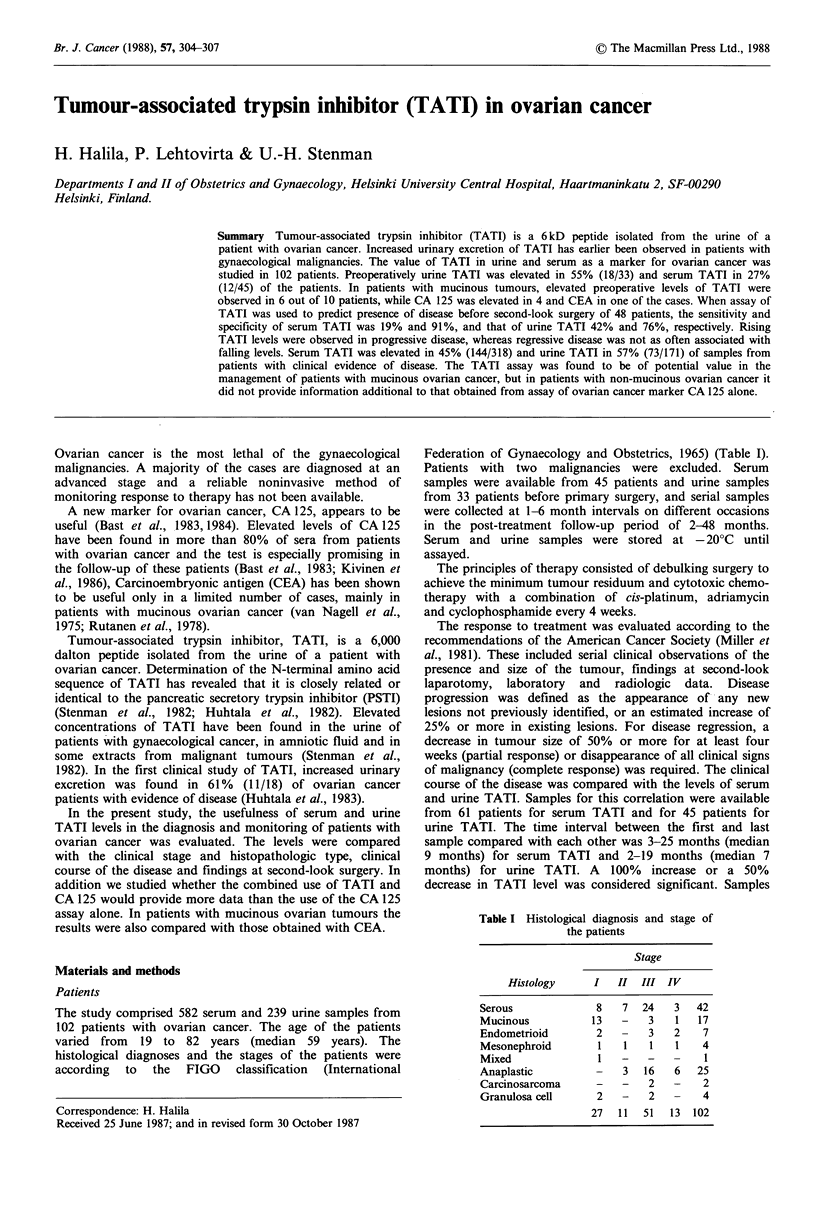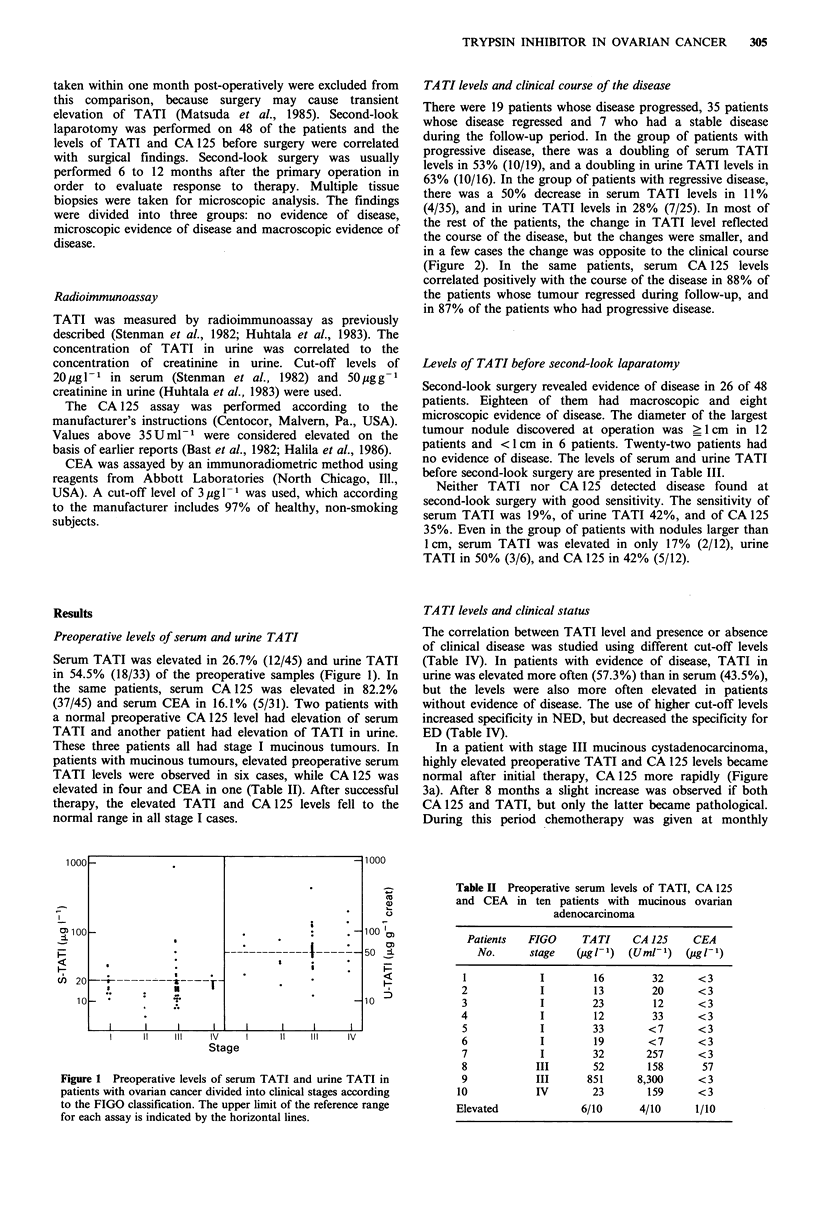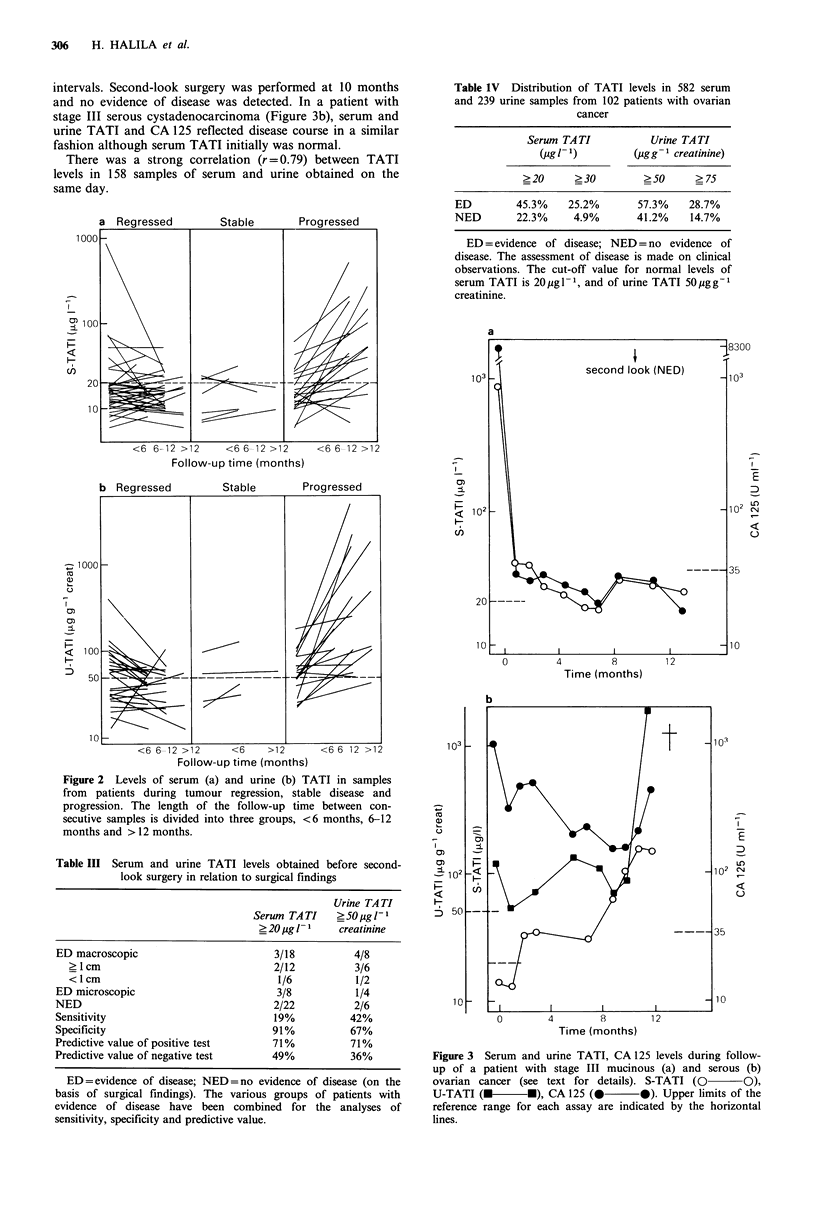Abstract
Tumour-associated trypsin inhibitor (TATI) is a 6 kD peptide isolated from the urine of a patient with ovarian cancer. Increased urinary excretion of TATI has earlier been observed in patients with gynaecological malignancies. The value of TATI in urine and serum as a marker for ovarian cancer was studied in 102 patients. Preoperatively urine TATI was elevated in 55% (18/33) and serum TATI in 27% (12/45) of the patients. In patients with mucinous tumours, elevated preoperative levels of TATI were observed in 6 out of 10 patients, while CA 125 was elevated in 4 and CEA in one of the cases. When assay of TATI was used to predict presence of disease before second-look surgery of 48 patients, the sensitivity and specificity of serum TATI was 19% and 91%, and that of urine TATI 42% and 76%, respectively. Rising TATI levels were observed in progressive disease, whereas regressive disease was not as often associated with falling levels. Serum TATI was elevated in 45% (144/318) and urine TATI in 57% (73/171) of samples from patients with clinical evidence of disease. The TATI assay was found to be of potential value in the management of patients with mucinous ovarian cancer, but in patients with non-mucinous ovarian cancer it did not provide information additional to that obtained from assay of ovarian cancer marker CA 125 alone.
Full text
PDF



Selected References
These references are in PubMed. This may not be the complete list of references from this article.
- Atack D. B., Nisker J. A., Allen H. H., Tustanoff E. R., Levin L. CA 125 surveillance and second-look laparotomy in ovarian carcinoma. Am J Obstet Gynecol. 1986 Feb;154(2):287–289. doi: 10.1016/0002-9378(86)90657-5. [DOI] [PubMed] [Google Scholar]
- Barbieri R. L., Niloff J. M., Bast R. C., Jr, Scaetzl E., Kistner R. W., Knapp R. C. Elevated serum concentrations of CA-125 in patients with advanced endometriosis. Fertil Steril. 1986 May;45(5):630–634. doi: 10.1016/s0015-0282(16)49333-7. [DOI] [PubMed] [Google Scholar]
- Bast R. C., Jr, Klug T. L., Schaetzl E., Lavin P., Niloff J. M., Greber T. F., Zurawski V. R., Jr, Knapp R. C. Monitoring human ovarian carcinoma with a combination of CA 125, CA 19-9, and carcinoembryonic antigen. Am J Obstet Gynecol. 1984 Jul 1;149(5):553–559. doi: 10.1016/0002-9378(84)90035-8. [DOI] [PubMed] [Google Scholar]
- Bast R. C., Jr, Klug T. L., St John E., Jenison E., Niloff J. M., Lazarus H., Berkowitz R. S., Leavitt T., Griffiths C. T., Parker L. A radioimmunoassay using a monoclonal antibody to monitor the course of epithelial ovarian cancer. N Engl J Med. 1983 Oct 13;309(15):883–887. doi: 10.1056/NEJM198310133091503. [DOI] [PubMed] [Google Scholar]
- Brioschi P. A., Irion O., Bischof P., Bader M., Forni M., Krauer F. Serum CA 125 in epithelial ovarian cancer. A longitudinal study. Br J Obstet Gynaecol. 1987 Mar;94(3):196–201. doi: 10.1111/j.1471-0528.1987.tb02353.x. [DOI] [PubMed] [Google Scholar]
- Haglund C., Huhtala M. L., Halila H., Nordling S., Roberts P. J., Scheinin T. M., Stenman U. H. Tumour-associated trypsin inhibitor, TATI, in patients with pancreatic cancer, pancreatitis and benign biliary diseases. Br J Cancer. 1986 Aug;54(2):297–303. doi: 10.1038/bjc.1986.176. [DOI] [PMC free article] [PubMed] [Google Scholar]
- Halila H., Huhtala M. L., Haglund C., Nordling S., Stenman U. H. Tumour-associated trypsin inhibitor (TATI) in human ovarian cyst fluid. Comparison with CA 125 and CEA. Br J Cancer. 1987 Aug;56(2):153–156. doi: 10.1038/bjc.1987.175. [DOI] [PMC free article] [PubMed] [Google Scholar]
- Halila H., Stenman U. H., Seppälä M. Ovarian cancer antigen CA 125 levels in pelvic inflammatory disease and pregnancy. Cancer. 1986 Apr 1;57(7):1327–1329. doi: 10.1002/1097-0142(19860401)57:7<1327::aid-cncr2820570713>3.0.co;2-z. [DOI] [PubMed] [Google Scholar]
- Huhtala M. L., Kahanpä K., Seppälä M., Halila H., Stenman U. H. Excretion of a tumor-associated trypsin inhibitor (TATI) in urine of patients with gynecological malignancy. Int J Cancer. 1983 Jun 15;31(6):711–714. doi: 10.1002/ijc.2910310606. [DOI] [PubMed] [Google Scholar]
- Huhtala M. L., Pesonen K., Kalkkinen N., Stenman U. H. Purification and characterization of a tumor-associated trypsin inhibitor from the urine of a patient with ovarian cancer. J Biol Chem. 1982 Nov 25;257(22):13713–13716. [PubMed] [Google Scholar]
- Kivinen S., Kuoppala T., Leppilampi M., Vuori J., Kauppila A. Tumor-associated antigen Ca 125 before and during the treatment of ovarian carcinoma. Obstet Gynecol. 1986 Apr;67(4):468–472. [PubMed] [Google Scholar]
- Matsuda K., Ogawa M., Shibata T., Nishibe S., Miyauchi K., Matsuda Y., Mori T. Postoperative elevation of serum pancreatic secretory trypsin inhibitor. Am J Gastroenterol. 1985 Sep;80(9):694–698. [PubMed] [Google Scholar]
- Miller A. B., Hoogstraten B., Staquet M., Winkler A. Reporting results of cancer treatment. Cancer. 1981 Jan 1;47(1):207–214. doi: 10.1002/1097-0142(19810101)47:1<207::aid-cncr2820470134>3.0.co;2-6. [DOI] [PubMed] [Google Scholar]
- Rutanen E. M., Lindgren J., Sipponen P., Stenman U. P., Saksela E., Seppäla M. Carcinoembryonic antigen in malignant and nonmalignant gynecologic tumors: circulating levels and tissue localization. Cancer. 1978 Aug;42(2):581–590. doi: 10.1002/1097-0142(197808)42:2<581::aid-cncr2820420226>3.0.co;2-g. [DOI] [PubMed] [Google Scholar]
- Stenman U. H., Huhtala M. L., Koistinen R., Seppälä M. Immunochemical demonstration of an ovarian cancer-associated urinary peptide. Int J Cancer. 1982 Jul 15;30(1):53–57. doi: 10.1002/ijc.2910300110. [DOI] [PubMed] [Google Scholar]
- van Nagell J. R., Jr, Pletsch Q. A., Goldenberg D. M. A study of cyst fluid and plasma carcinoembryonic antigen in patients with cystic ovarian neoplasms. Cancer Res. 1975 Jun;35(6):1433–1437. [PubMed] [Google Scholar]


